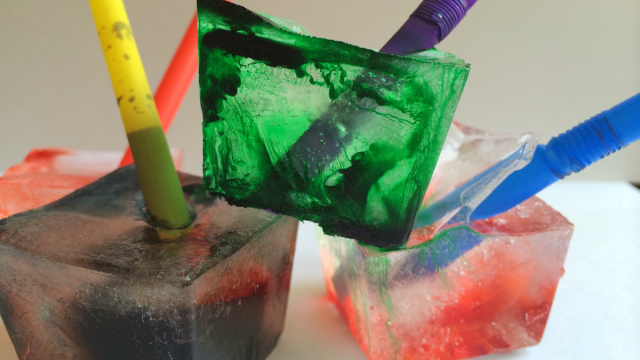Frozen carbon dioxide, a.k.a. dry ice, is frozen at a temperature of negative 109 degrees Fahrenheit
Experimenting with ice is cool. But dry ice experiments are even cooler! Unlike the ice cubes in your freezer, dry ice doesn’t melt into liquid. Instead, these blocks sublimate, which means instead of transforming from a solid to a liquid, dry ice goes from a solid to a gas. With the proper precautions, this type of science experiment for kids is safe—so grab gloves and tongs, open a window or take the CO2 outdoors, follow these guidelines from the National Weather Service, and check out these awesome dry ice experiments.
Blow Up a Balloon
The air from your lungs isn’t the only way to blow up a balloon. This chilly experiment from Science Kiddo helps your budding scientist explore the properties of dry ice.
Build a Volcano
Check out this awesome overflowing dry ice volcano experiment from Life with Moore Learning! As if this isn’t enough fun, you'll also get a step-by-step guide to help your kids compare regular ice with dry ice and other freezing explorations.
Plan a Potion
Whether you want to make a witch’s brew for your family's Halloween monster bash or you just want to mix up a cool (literally) concoction, Our Best Bite’s Mad Scientist Potion has everything you need to make a mocktail that’s overflowing with fog.
Related: 70+ Easy Science Experiments for Kids to Try at Home
Find Fog—Magically
Make your own at-home outdoor fog machine with two ingredients—dry ice and hot water. Remember, dry ice doesn’t melt into a liquid. Instead, it sublimates or turns into a vapor. Place blocks of dry ice into a glass or bucket of hot water and then stand back and watch as the fog pours across your yard!
Put Out a Candle
Can dry ice help extinguish a candle quickly? Your littles can easily blow out their bday cake candles, but have they ever used dry ice to make a flame go away? Head over to Life with Moore Learning for the how-to steps to this easy science exploration.
Make a Bubble Ball
How can your kids make a crystal ball? Gather a few pieces or pellets of dry ice, a bowl, dish soap and a kitchen towel. Put the dry ice into the bowl, add hot water and watch the fog show begin. Even though this is exciting, it’s not where the experiment ends. Dip the dish towel into a soapy solution, and spread it around the rim of the bowl. Gently pull the soap-soaked towel across the bowl and watch as a ball-like bubble emerges in front of your eyes.
Compare and Contrast
How does dry ice melt? The answer isn't regular ice. While you might already know this, your child doesn’t. Freeze water, juice, soda, milk, and any other liquid you want. Put the frozen liquid cubes on plates and create a comparison plate with dry ice. Watch each ice option carefully. Your child can jot down what happens to each piece of ice and when.
Related: It’s Alive! Gross (But Cool) Science Experiments for Kids
Inflate a Glove
If you have boxes of plastic or latex gloves hanging around your home, forget about cleaning. It’s time to put these gloves to scientific use, as they are a great substitute for balloons. Drop a shred of dry ice into the glove, tie the end and watch it magically grow. Hint: Don’t use too much dry ice for this experiment. A pellet will do. Overdoing it with the frozen CO2 might create too much gas, causing the glove to burst.
Bubbles and More Bubbles
You’ve covered dry ice with water and watched it fog. But what happens if you put the frozen CO2 into a bath of bubbles? Use your kiddo’s paddling pool or fill the sand table with a water and bubble solution or dish soap mix. Ask your child to predict what will happen as the dry ice sublimates. Observe the bubbles as the CO2 gas fills the water and moves into suds.
Magical Disappearing Ice
When regular ice melts it leaves behind a puddle, but the same isn't true for dry ice. Again, the sublimation process causes it to turn into a gas state. Help your child learn more about the states of matter with easy observation-based science exploration. Place a piece of dry ice in a bowl outside on a warm day or in the sun. Ask your child to predict what they think will happen to the dry ice. Go back later in the day and take a look at the bowl. Like magic, the ice is gone, and nothing is left behind. Discuss what happened. Your child can hypothesize where the ice went and why there is no water in the bowl.
Related: 6 Incredibly Easy Rainbow Science Experiments
